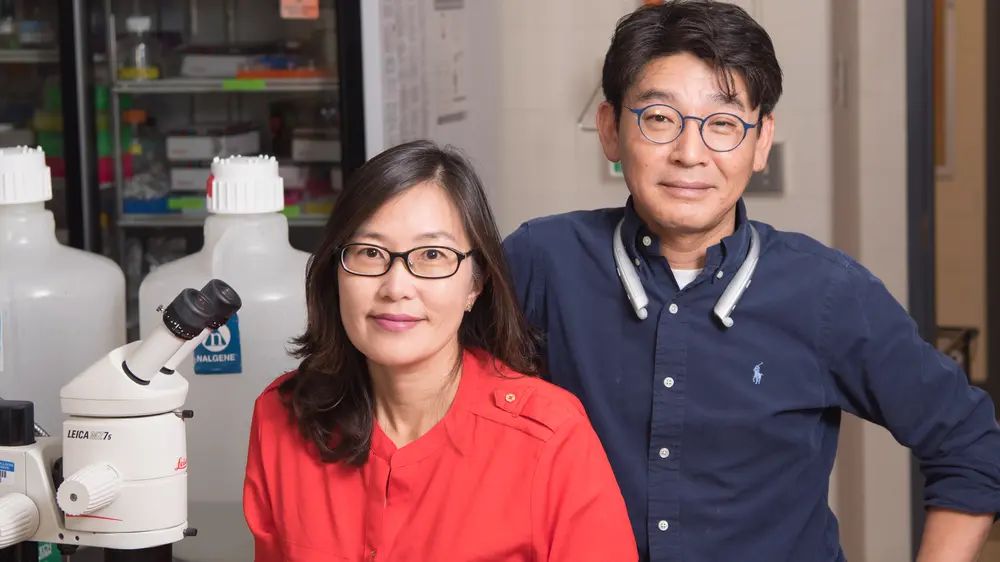
Molecular and integrative physiology professor Hee Jung Chung (left), postdoctoral fellow Eung Chang Kim (right), and their colleagues discovered that abnormal expression and phosphoinositide regulation of KCNQ/Kv7 potassium channels underlie neuronal hyperexcitability and injury in early-onset epileptic encephalopathy characterized by drug-resistant seizures and severe psychomotor retardation.
Researchers at the University of Illinois have identified multiple novel pathogenic mechanisms underlying de novo dominant mutations in Kcnq2, which cause epileptic encephalopathy. This genetic epilepsy is characterized by drug resistant seizures, developmental delay, and profound psychomotor impairment. The Kcnq2 gene encodes Kv7.2, one of the principle subunits of KCNQ/Kv7 potassium channels that potently suppress repetitive and burst firing of action potentials.
Their findings, reported recently in the journal Neurobiology of Disease, present a novel concept that multiple defects in KCNQ/Kv7 potassium channels could exert more severe impacts on neuronal excitability and health during the pathogenesis of Kcnq2 epileptic encephalopathy.
KCNQ/Kv7 channels composed of Kv7.2 and Kv7.3 subunits open by sensing membrane depolarization and this opening requires the channel binding to phosphoinositide called PIP2. In an earlier study, Chung lab found that Kv7 channels are enriched at the axonal plasma membrane where action potential generates and propagates and that their axonal targeting requires the interaction between Kv7.2 subunit and calcium-binding protein calmodulin.
The researchers first noticed that many of these pathogenic epilepsy mutations are located intracellularly in Kv7.2 far from where the potassium ion permeates or where the channel senses voltage change.
“We focused on understanding the Kv7.2 mutations located intracellularly at or near the binding site for calmodulin,” said Hee Jung Chung, a University of Illinois Professor of Molecular and Integrative Physiology who led this new research.
“Although these mutations indeed variably disrupt Kv7.2 interaction with calmodulin and decrease the channel localization at the axonal plasma membrane, another major problem of these mutant channels was that they are insensitive to PIP2. These mutant channels are less on the axonal plasma membrane and cannot open effectively. Such combination results in the inability of Kv7 channels to suppress neuronal excitability,” said Chung.
“These findings are very exciting because they suggest an interesting concept that PIP2 and CaM binding must be working together to modulate voltage sensing and the potassium ion permeation of the channels”, said Chung.
The researchers also discovered that one particular mutation M518V cause most defects in Kv7 channels by severely decreasing their binding to calmodulin, axonal surface expression, and potassium currents. Surprisingly, this mutant Kv7.2 protein gets quickly degraded by ubiquitination and proteasome, but starts to accumulate and aggregate in the cell when Kv7.3 is present. Expression of this mutant Kv7.2 only for 24 hours also causes cell death in both non-neuronal cells and neuronal cells in culture. “These findings are the first to show that expression of epilepsy mutant Kv7.2-M518V causes cell death and is consistent with clinical studies reporting the evidence for sclerosis in the brain of some patients with Kcnq2 epileptic encephalopathy. It is possible that such progressive neuronal death may result in the rearrangement of neuronal circuitry that ultimately contributes to the development of drug-resistant seizures and psychomotor retardation in this disease,” said Chung.
As a future direction, the researchers made the transgenic mice in which the expression of M518V mutant Kv7.2 can be controlled in specific part of the brain.
“This novel mouse line will allow us to dissect the relationship between seizure generation and the progression of neuronal death. Furthermore, we can use this mouse model to explore the efficacy of drugs in clinical use or novel drugs for neurodegeneration and epilepsy.”
Such therapeutic intervention may help the children who has this devastating epilepsy.
This study is supported by Epilepsy Foundation, Roy J. Carver Charitable Trust Foundation, and the National Institutes of Health Grant R01 NS083402.
